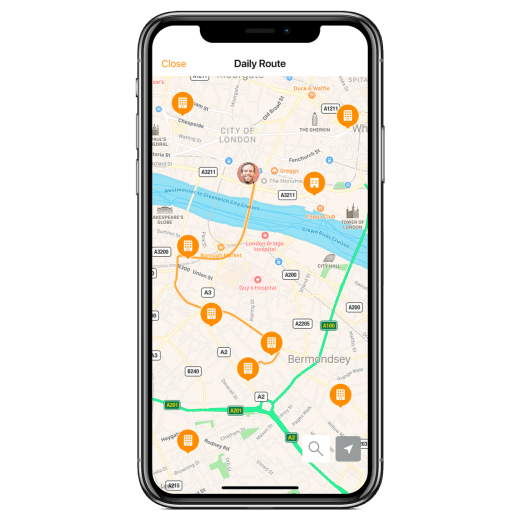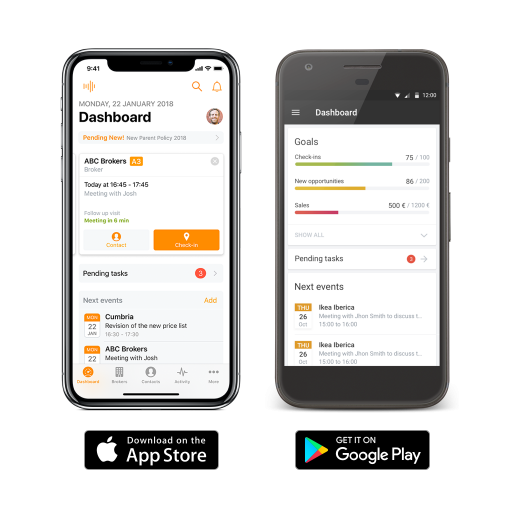6 min read
A customer relationship management (CRM) implementation or that of any new business software for that matter, isn’t easy. The main sticking point being a headstrong sales team.
Sales reps do things a certain way (and often have done for a long time now…) making them very resistant to change.
However, the benefits of a successful CRM software implementation are too great to be ignored:
This is why I implore managers to persevere with their CRM implementation despite the grumblings echoing back off the saleroom floor – the benefits far outweigh the costs.
To make things easier I’ve put together a list of five recommendations for ensuring your CRM implementation is a resounding success. Keep in mind that, as in life, each organization and sales team is different, so the initial risk analysis and the design of your CRM implementation model is paramount if you are to be successful.
The CRM software market grew at a rate of 15.6% to reach $48.2 billion in 2018, according to a recent survey by Garnter. This means CRM remains both the largest and fastest growing enterprise application software category in the world.
However, while the growth of the market is undeniable there is still an underlying problem with CRM implementation. A study by Statista discovered that 30% of US companies using CRM software stated that their organization was not effective at delivering real-time customer interactions across touchpoints and devices.
This is primarily down to poor user adoption rates and a perceived element of control from the front-end users. Many believe CRM to be nothing more than the sales director’s “Big Brother,” referring to the reality TV series which sees volunteers share are a house with strangers for a number of weeks under 24-hour surveillance.
Not only are their problems with perceived control, but many salespeople complain that CRM software adds little to no value in their day-to-day work. Rather the opposite, in fact, with many citing increased hours of admin work and less time in front of clients as a result.
Unfortunately this perceived lack of value leads to a complete abandonment of these systems that were actually designed and built to help them…
The good news is that were are entering the era of personal assistants (Siri, Cortana, Alexa, Google Assistant etc.) a sub-series of technology built specifically to work for people, not the other way around.
This technology can (and is being) applied to many modern mobile CRM systems to actively help salespeople out in the field. These apps provide reps with contextual information based on their real-time location/situation.
Systems such as ForceManager can be conversed with by sales reps thanks to natural language processing (NLP) technology to not only save time when updating the CRM with post-visit data, but also in giving advice to reps regarding their upcoming visit.
For example, a field sales representative driving between visits can listen to their CRM as it analyzes millions of data points to find the best possible cross-sell and upsell opportunities for that visit, increasing the potential value of that customer. Also the system updates itself to real-time traffic conditions, readjusting to the quickest route to a client meeting as well as giving the rep the option to call the client and let them know they’re running late – all this hands-free without having to leave the application’s dashboard.

These and many other features designed to help sales reps in their day-to-day work drastically increase a CRM’s adoption rate as reps start to see their true value. The knock-on effect is that the more a system is used, the higher quantities of quality, real-time data being entered. This gives managers more insight into their sales process and the ability to make tactical decisions accordingly.
When starting your CRM implementation model I recommend you discuss the vendor’s roadmap for AI incorporation and usability of their mobile application. The two are fundamental in the system’s user uptake success and consequently, your CRM implementation’s success as a whole.
If we look at the main characteristics of a sales rep I think we can all agree that individualism, persistence and goal-orientated would top the list . This makes them very focused on results and committed to hitting objectives which fortunately for us, is essential for high performance teams.
These characteristics mean that sales reps are used to having a lot of freedom when it comes to processes and how they work, as they are only measured by a single metric (sale or non-sale).
This means a new CRM implementation is a scary prospect for sales directors who don’t want to upset the Status Quo of the team. I don’t know how many times I’ve heard… “this CRM is amazing, but I am afraid of the reaction of my team,” to which I always respond, “fear of what?”
Personally I believe that NO salesperson is indispensable, not even the strongest members of the team. If your success is based solely and exclusively on the talent of one or two individuals and you do not have a replicable, scalable business model then you’re running as an extremely high-risk company.
Now that is scary!
You have to get the entire sales team onboard using the CRM to understand how that top 1% of your team operate, so that it can be replicated in other areas of the business.
That being said, general management play a key role in CRM implementation and more importantly, selection which is where my third recommendation comes in.
Salespeople like warm leads, time in front of customers and above all, the ability and freedom in closing deals. What they do not like is to spend entire days bogged down in their CRM filling out complicated forms and other arduous administrative tasks.
We must, therefore, find a system that reaches a compromise between information quality and sales agility.
During the hundreds of digital sales transformation projects I’ve led throughout my professional career there’s never been anything more tempting than a complex, potentially game-changing data analysis and information entry system. They promise unprecedented levels of insight and and an ability to dwarf our previous annual sales revenue figures.
The problem is, almost all of these types of CRM implementation fail. In fact, thinking back I can’t recall a single one you’d call a “resounding success”.
The problem almost always comes down to the system’s usability.
Put yourself in the salesperson’s shoes. If they spend most of their time travelling between meetings, in the car and out of the office then mobility is going to be key. Therefore the chosen CRM provider should have strong mobile capabilities with a native application for iOS (Apple) and Android (Google). This means the user interface will be easy to navigate with simple, uncomplicated workflows to follow.

If you focus on simplicity the initial adoption levels will be high with salespeople becoming increasingly accustomed to using the system. Once that initial phase is over, that’s when you can start thinking of layering more complex systems and features into your CRM. Those advanced levels of data analysis you were promised beforehand come after adoption has taken hold, not beforehand.
What I’m referring to here is that level of excitement (or at the very least optimism) that permeates through management whenever a new sales tool has been decided upon.
This is your moment to address any potential problems which may arise during future stages of the CRM implementation model.
For example, this could include areas such as:
Like I said, discussion around these areas should take place as soon as the CRM implementation is given the green light – you’ll find everyone a lot more amiable and easier to collaborate with while spirits are high.
Finally, the last piece of CRM implementation advice I’m going to give is to involve the company’s natural leaders in the project. Natural leaders are those people within the organization who, without necessarily holding a key stakeholder position, have the trust and respect from the rest of their partners. Having them by your side is going to make the CRM implementation process so much easier, as they are the ones who create a “trendy” path for the rest to follow.
At ForceManager I have overseen CRM implementation projects at companies of various sizes and differing industries, but the one underlying factor behind nearly all our successful projects has been the role of company ambassadors. Unless you work at a company where changes are made by a strict, hierarchical management structure and followed without question, then my recommendation is to keep these natural leaders or ambassadors in mind.
These are undoubtedly my five key recommendations to keep in mind when undertaking a CRM implementation project. Invest in a tool that’s simple, easy-to-use and created by salespeople for people as you can be sure it meets the needs of your sales team.